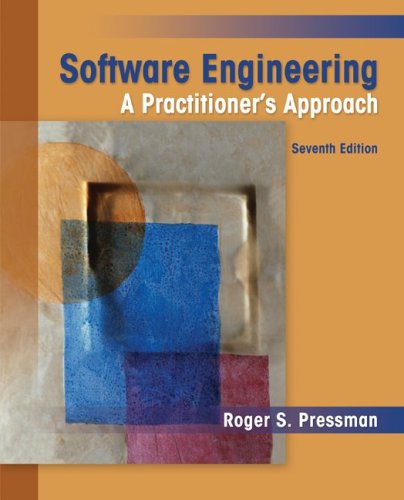
Software Engineering: A Practitioner’s Approach, 7th Edition
- Length: 928 pages
- Edition: 7
- Language: English
- Publisher: McGraw-Hill Science/Engineering/Math
- Publication Date: 2009-01-20
- ISBN-10: 0073375977
- ISBN-13: 9780073375977
- Sales Rank: #830543 (See Top 100 Books)
For almost three decades, Roger Pressman’s Software Engineering: A Practitioner’s Approach has been the world’s leading textbook in software engineering. The new seventh edition represents a major restructuring and update of previous editions, solidifying the book’s position as the most comprehensive guide to this important subject.
The seventh edition of Software Engineering: A Practitioner’s Approach has been designed to consolidate and restructure the content introduced over the past two editions of the book. The chapter structure will return to a more linear presentation of software engineering topics with a direct emphasis on the major activities that are part of a generic software process. Content will focus on widely used software engineering methods and will de-emphasize or completely eliminate discussion of secondary methods, tools and techniques. The intent is to provide a more targeted, prescriptive, and focused approach, while attempting to maintain SEPA’s reputation as a comprehensive guide to software engineering.
The book will be organized in five (5) parts-Process, Modeling, Quality Management, Project Management, and Advanced Topics. The chapter count will remain at 32, unchanged from the sixth edition. However, eight new chapters have been developed and another six chapters have undergone major or moderate revisions. The remaining chapters have undergone minor edits/updates.
Table of Contents
Chapter 1: Software And Software Engineering
Part One: The Software Process
Chapter 2: Process Models
Chapter 3: Agile Development
Part Two: Modeling
Chapter 4: Principles That Guide Practice
Chapter 5: Understanding Requirements
Chapter 6: Requirements Modeling: Scenarios, Information, And Analysis Classes
Chapter 7: Requirements Modeling: Flow, Behavior, Patterns, And Webapps
Chapter 8: Design Concepts
Chapter 9: Architectural Design
Chapter 10: Component-Level Design
Chapter 11: User Interface Design
Chapter 12: Pattern-Based Design
Chapter 13: Webapp Design
Part Three: Quality Management
Chapter 14: Quality Concepts
Chapter 15: Review Techniques
Chapter 16: Software Quality Assurance
Chapter 17: Software Testing Strategies
Chapter 18: Testing Conventional Applications
Chapter 19: Testing Object-Oriented Applications
Chapter 20: Testing Web Applications
Chapter 21: Formal Modeling And Verification
Chapter 22: Software Configuration Management
Chapter 23: Product Metrics
Part Four: Managing Software Projects
Chapter 24: Project Management Concepts
Chapter 25: Process And Project Metrics
Chapter 26: Estimation For Software Projects
Chapter 27: Project Scheduling
Chapter 28: Risk Management
Chapter 29: Maintenance And Reengineering
Part Five: Advanced Topics
Chapter 30: Software Process Improvement
Chapter 31: Emerging Trends In Software Engineering
Chapter 32: Concluding Comments
Appendix 1: An Introduction To Uml
Appendix 2: Object-Oriented Concepts







